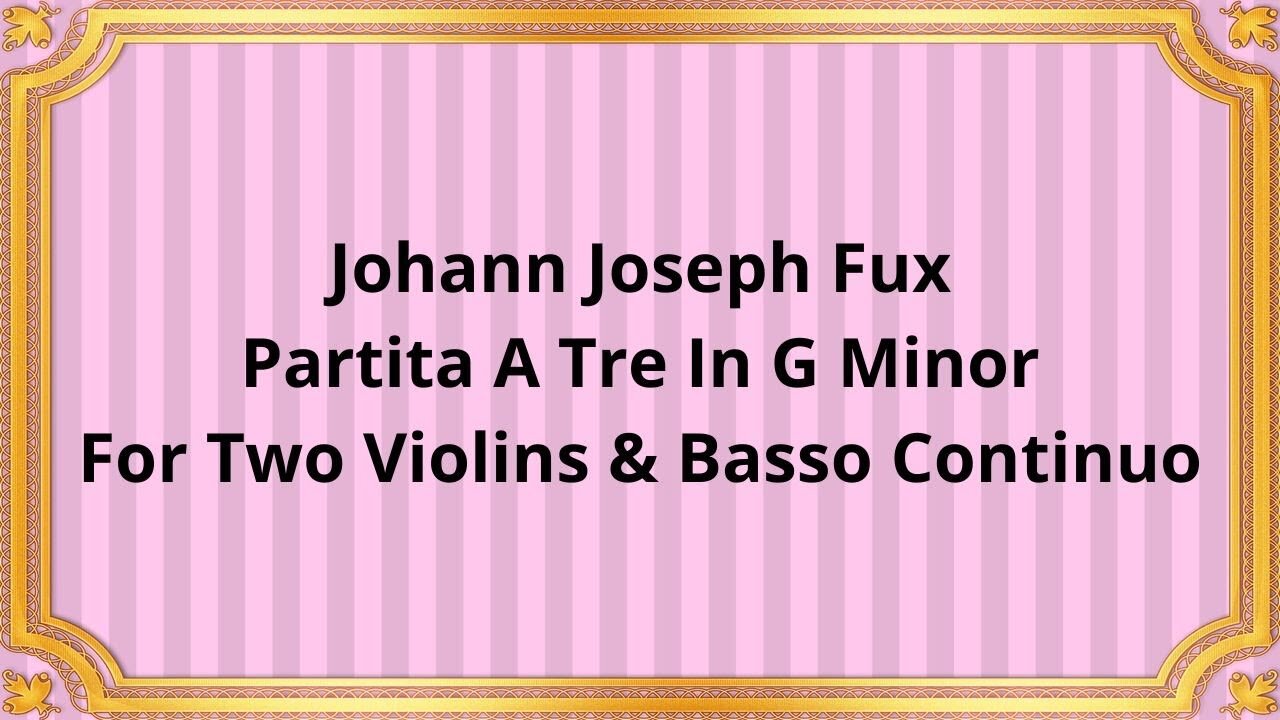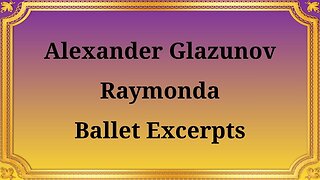Premium Only Content

Johann Joseph Fux Partita A Tre In G Minor For Two Violins & Basso Continuo
#ClassicalMusic #JohannJosephFux #PartitaATre #GMinor #TwoViolins #BassoContinuo #MusicalComposition #BaroqueMusic
Ernst Prappacher, Bassoon
Marga Scheurich, Harpsichord
Jorg-Wolfgang Jahn and Jurgen Wolf, cello
Johann Joseph Fux's Partita A Tre In G Minor for Two Violins & Basso Continuo is a remarkable composition that showcases the brilliance of classical music during the Baroque period.
Johann Joseph Fux, an influential Austrian composer and music theorist, composed the Partita A Tre in the early 18th century. Fux was highly regarded for his mastery of counterpoint, a technique that is evident in this composition. The Baroque era, known for its ornate and elaborate musical style, provided the perfect backdrop for Fux's creativity and innovation.
The Partita A Tre in G Minor is written for two violins and basso continuo, a bass instrument that provides harmonic support. It is divided into several movements, each showcasing different moods and musical ideas. The piece follows the traditional dance suite structure, consisting of an opening movement, followed by a series of stylized dances such as allemande, courante, sarabande, and gigue.
Fux's expert use of counterpoint is evident throughout the composition. The interplay between the two violins, with their intertwining melodies and harmonies, creates a rich tapestry of sound. The basso continuo adds depth and rhythmic stability, providing a solid foundation for the ensemble.
The Partita A Tre in G Minor is characterized by its emotional depth and expressive qualities. Fux skillfully weaves together moments of tension and resolution, creating a captivating musical narrative. The slower movements, such as the sarabande, showcase Fux's ability to evoke deep emotions through the use of expressive melodies and poignant harmonies. The faster movements, such as the gigue, are filled with energy, showcasing Fux's mastery of rhythmic complexity.
Fux's Partita A Tre in G Minor is a testament to the rich musical heritage of the Baroque period. It exemplifies the technical and artistic innovations of the time, with its intricate contrapuntal writing and elaborate ornamentation. This piece, along with Fux's other compositions, greatly influenced subsequent generations of composers, leaving a lasting impact on the development of classical music.
Conclusion:
Johann Joseph Fux's Partita A Tre In G Minor for Two Violins & Basso Continuo stands as a testament to the artistry and brilliance of classical music during the Baroque period. Its intricate structure, emotional depth, and historical significance make it a captivating composition that continues to enthrall audiences to this day. Through its exploration of counterpoint and expressive melodies, this piece serves as a timeless reminder of the beauty and power of classical music.
You have the opportunity to support the channel:
https://destream.net/live/RadSiarAl/donate
https://www.buymeacoffee.com/6355radsiaral
-
 52:11
52:11
Classical music_Music Inspiration
28 days agoAlexandra Glazunov Excerpts from the ballet "Raymonda"
911 -
 22:47
22:47
The Pascal Show
11 hours agoTHEY’RE HIDING EVIDENCE?! Candace Owens EXPOSES Foreign Connection In Charlie Kirk Shooting
501 -
 LIVE
LIVE
Lofi Girl
3 years agolofi hip hop radio 📚 - beats to relax/study to
162 watching -

FreshandFit
11 hours agoLas Vegas Takeover!
159K13 -
 2:19:29
2:19:29
Badlands Media
11 hours agoDevolution Power Hour Ep. 404
62.9K30 -

Drew Hernandez
1 day agoGOP COOKED INTO DENIAL & 12 ISRAELI-LINKED PHONES DETECTED AT UVU DAY OF CK EXECUTION?
38.8K22 -
 2:46:08
2:46:08
TimcastIRL
7 hours agoFAA To STOP Flights Over Shutdown, May CLOSE Airspace, Thanksgiving Travel APOCALYPSE | Timcast IRL
187K105 -
 1:56:20
1:56:20
Tucker Carlson
7 hours agoIt’s Time to Decide: America First or Lindsey Graham’s Psychosexual Death Cult?
98.5K388 -

SpartakusLIVE
9 hours agoBattlefield 6 - REDSEC || ARC Raiders Later? || Anybody Want Warzone???
70.1K5 -
 3:56:11
3:56:11
Alex Zedra
6 hours agoLIVE! Spooky Games tn
47.4K3